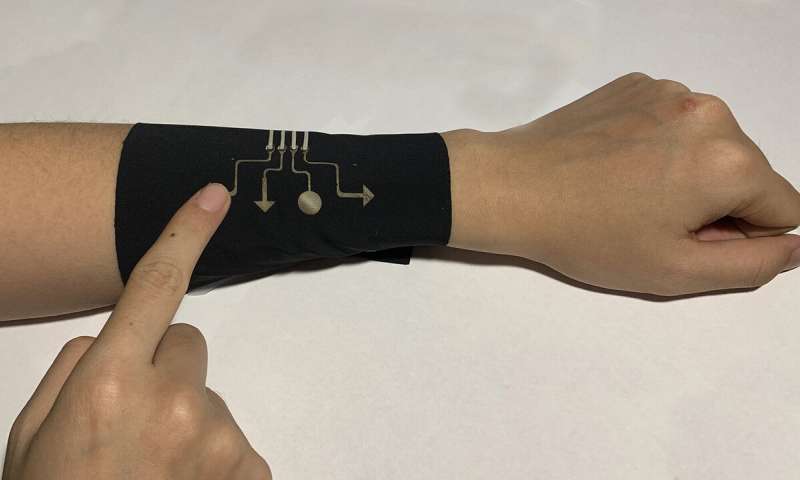Electronics has already changed the way we live by playing the universal role in almost every sphere of our life. To make it (electronics) more important and useful are the emergence of continuous scientific and engineering developments in materials at nanoscale with exotic characteristics like electrical conductivity, flexibility, heat capacity etc. Over the years, wearable and flexible electronics with diverse functions have inspired increasingly widespread interests both from industrial circle and academic community.
These emerging products are expected to open up a new class of potential applications ranging from personal entertainment, health monitoring, virtual reality, human-machine interfaces and even Internet of Things. Generally, current wearable technology is primarily focused on the integration of rigid, conventional electronic parts in the flexible plastic or elastic rubber substrates. It remains both a challenge and highly desirable to develop more advanced future wearable technology with intrinsically soft materials and new designs. Fabric-based materials are very common for human being thousands of years and they can effectively accommodate the complex deformations induced by body motions. A smart fabric with compelling features of being lightweight, flexible, breathable, shape conformal and even washable provides a novel way of designing functional next-generation wearable electronics.
Stretchable electronics is a technology field with revolutionary potential. They provide consumers with highly personalized experiences. This technology can be used to monitor vital signs for an extended period of time. However, there’s one big hurdle to its usability, and that is the lack of breathability. Stretchable electronics has already been there for quite some time now but the development of materials exhibiting gas permeability is the big advance over earlier stretchable electronics. Moreover, the method used for creating the material is a simple process that would be easy to scale up. The researchers used a technique called the breath figure method to create a stretchable polymer film featuring an even distribution of holes. The film is coated by dipping it in a solution that contains silver nanowires. The researchers then heat-press the material to seal the nanowires in place. This allows for better contact with the skin, giving the electronics a better signal-to-noise ratio. According to researchers, the resulting film shows an excellent combination of electric conductivity, optical transmittance and water-vapor permeability. And because the silver nanowires are embedded just below the surface of the polymer, the material also exhibits excellent stability in the presence of sweat and after long-term wear.
Now, researchers have created ultrathin, stretchable electronic material that is gas permeable, allowing the material to 'breathe.' According to the researchers used what’s known as the ‘breath figure’ method—a method used to form porous films from water droplet templates—to create a stretchable polymer film featuring an even distribution of holes. Breath figures are formed by water microdroplets condensed on a cool surface from warm, humid air like breath. The film is then coated by dipping it in a solution that contains silver nanowires (AgNWs). Finally, the material is heat-pressed to seal the nanowires. The resulting film has a transmittance of 61%, the sheet resistance of 7.3 Ω/sq, and water vapor permeability of 23 mg cm−2 h−1 which an excellent combination of electric conductivity, optical transmittance, and water-vapor permeability The material was designed specifically for use in biomedical or wearable technologies, since the gas permeability allows sweat and volatile organic compounds to evaporate away from the skin, making it more comfortable for users -- especially for long-term wear. If a wearable device is not gas permeable, it can also cause skin irritation therefore gas permeability of wearable electronics is important for more than just comfort. The end result is an extremely thin (only a few micrometers thick) product which allows for better contact with the skin, giving the electronics a better signal-to-noise ratio.
To demonstrate the material's potential for use in wearable electronics, the researchers have developed and tested prototypes for two representative applications. The first prototype consisted of skin-mountable, dry electrodes for use as electrophysiologic sensors. These have multiple potential applications, such as measuring electrocardiography (ECG) and electromyography (EMG) signals. Accordingly, these sensors were able to record signals with excellent quality, on par with commercially available electrodes. The second prototype demonstrated textile-integrated touch sensing for human-machine interfaces. The researchers used a wearable textile sleeve integrated with the porous electrodes to play computer games. In order to develop wearable sensors or user interfaces that can be worn for a significant period of time, we need gas-permeable electronic materials so development of breathable electronics is a significant step forward.
Electronics designed to stick to skin and transmit the body’s electric signals could improve the sensitivity of prosthetics or help doctors monitor patients’ vital signs. Unfortunately, conventional electrodes used for this purpose trap air and sweat against skin, causing irritation or inflammation when used for an extended period. However, the development of a conductive gold nanomesh that is flexible and breathable while relaying electric signals will play a great role.
